Related Research Articles

Hangzhou, also romanized as Hangchow, is the capital and most populous city of Zhejiang, China. It is located in the northwestern part of the province, sitting at the head of Hangzhou Bay, which separates Shanghai and Ningbo. Hangzhou grew to prominence as the southern terminus of the Grand Canal and has been one of China's most renowned and prosperous cities for much of the last millennium. It is a major economic and e-commerce hub within China, and the second biggest city in Yangtze Delta after Shanghai. Hangzhou is classified as a sub-provincial city and forms the core of the Hangzhou metropolitan area, the fourth-largest in China after Guangzhou-Shenzhen Pearl River agglomeration, Shanghai-Suzhou-Wuxi-Changzhou conurbation and Beijing. As of the 2020 Chinese census, it had a total population of 11,936,010 inhabitants. However, its metropolitan area, populated by 13.035 million people over an area of 8,107.9 km2 (3,130.5 sq mi), consists of all urban districts in Hangzhou and 3 urban districts of the city of Shaoxing.

Zhejiang University, abbreviated as ZJU or Zheda and formerly romanized as Chekiang University, is a national public research university based in Hangzhou, Zhejiang, China. It is a member of the prestigious C9 League and is selected into the national higher education plans including Double First Class University Plan, Project 985, and Project 211. Consistently ranked among the top 5 academic institutions in mainland China, ZJU is one of the most prestigious universities in China. ZJU is ranked 5th in Asia and 42nd globally by QS World University Rankings and ranked 36th in the world and 5th in Asia & Oceania region by the Academic Ranking of World Universities (ARWU) as of 2022.
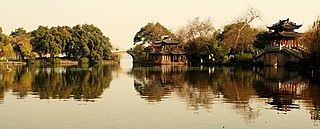
West Lake is a freshwater lake in Hangzhou, China. It is divided into five sections by three causeways. There are numerous temples, pagodas, gardens, and natural/artificial islands within the lake. Gushan (孤山) is the largest natural island and three artificial islands: Xiaoyingzhou (小瀛洲), Huixin Pavilion (湖心亭), and Ruan Gongdun (阮公墩) stand at the middle of the lake. Leifeng Pagoda (雷峰塔) and Baochu Pagoda (保俶塔) are separated by the lake. Mirroring each other, the basic pattern of "one mountain, two towers, three islands, three banks, and five lakes" is formed.

Queenstown is a planning area and satellite residential town situated on the south-westernmost fringe of the Central Region of Singapore. It borders Bukit Timah to the north, Tanglin to the northeast, Bukit Merah to the east and southeast, as well as Clementi to the northwest and west. Its southern and southwesternmost limits are bounded by the Pandan Strait.
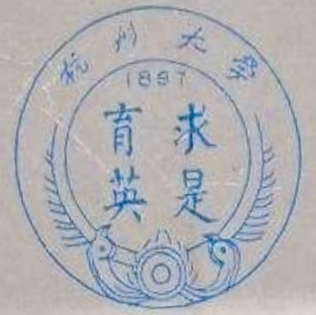
Hangzhou University, colloquially called Hangda and formerly romanised as Hangchow University, was a public university in Hangzhou, Zhejiang, China. The university was founded as Zhejiang Teachers College in 1952 by merging the departments of humanities, sciences and education at Hangchow University and Zhejiang University. The name of the university in postal romanisation is the same as Hangchow University run by American missionaries, yet the Chinese names are different.
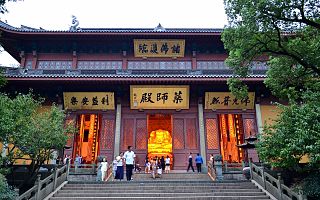
Lingyin Temple is a Buddhist temple of the Chan sect located north-west of Hangzhou, Zhejiang Province, China. The temple's name is commonly literally translated as Temple of the Soul's Retreat. It is one of the largest and wealthiest Buddhist temples in China, and contains numerous pagodas and Buddhist grottoes.
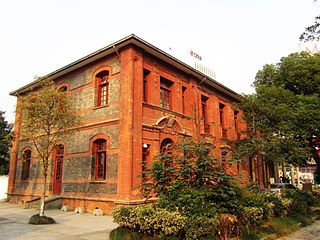
Hubin Campus, was a defunct urban campus of the Zhejiang University. The campus was the campus of Zhejiang Medical University before it was merged into Zhejiang University in 1998.

Zhijiang Campus is an urban campus of Zhejiang University located in Hangzhou, Zhejiang, China. Located on riverside of the Qiantang River and close to the Liuhe Pagoda, it was the oldest university campus in Hangzhou. Built as the campus of Hangchow University, one of the oldest Christian colleges and universities in China, most of its buildings are protected as the Hangchow University Historic Site under the list of Major Sites Protected at the National Level. The campus is now home to James D. Watson Institute of Genome Sciences, Guanghua Law School and the Institute for Advanced Study in Humanities and Social Sciences.

Zijingang Campus is the main campus of Zhejiang University. Located in the west of urban Hangzhou, it borders the Yuhangtang River in the south, hence the name. With an area of 8,700 mu, it is the largest single university campus in Mainland China.
Binjiang is one of ten urban districts of the prefecture-level city of Hangzhou, the capital of Zhejiang Province, in East China, it is located in the core urban area of Hangzou. It is across the Qiantang River from West Lake and the older parts of Hangzhou. Like Pudong in Shanghai, it a very modern, and rapidly developing, area that was mostly farmland until ten years ago. The district's total area is 72.2 square kilometres (27.9 sq mi), and its population totals 455,000 people. The district people's government is situated on Xixing Road.
Hangzhou historic houses are artifacts, buildings, or districts in Hangzhou, China, which have been legally declared to be "protected". According to the "Regulations of historic districts and historic buildings in Hangzhou" effectivated from 1 January 2005, historic buildings are those artifacts or districts that have lasted more than 50 years, and are of significant value for history, science, and art. In Hangzhou, declaring a historic house requires consulting the urban planning administration bureau, and the real estate administration bureau.
The following is a timeline of the history of the city of Hangzhou, Zhejiang Province, China.

Zhejiang University-University of Edinburgh Institute, also known as Zhejiang-Edinburgh Institute and ZJU-UoE Institute, is an international joint academic and research institution based in Haining, Zhejiang Province, China. Founded in 2014, The Zhejiang University-University of Edinburgh Institute (ZJE) is a collaboration in the field of Biomedical Sciences between Zhejiang University, China and The University of Edinburgh, United Kingdom. Students are awarded with a University of Edinburgh degree as well as a degree from Zhejiang University. All programmes are taught in English and form part of the University of Edinburgh Medical School offering.

Westlake University, previously the Westlake Institute for Advanced Study, is a private research university in Hangzhou, Zhejiang, China. The university is founded on October 20, 2018.
19 Jinchaidai Alley, in Shangcheng District, Hangzhou, Zhejiang, China, is a former residence constructed during the Qing dynasty, which was used during the Xinhai Revolution that led to the dynasty's collapse. Despite concerns over its historical significance, the building began to be demolished in 2010 despite its addition to the fifth batch of protected historical buildings in Hangzhou earlier that year, although its demolition was stopped by the city government's intervention. The building has now been renovated, and serves as part of the campus of the Jianlan Middle School's Lanxin Academy of Classical Learning, a private school in the city.
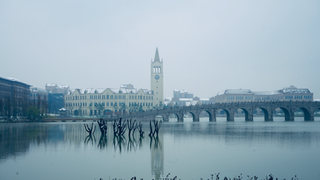
The International Campus, Zhejiang University, located in Haining, Zhejiang, China, is a Zhejiang University (ZJU) campus that came into use in 2016 as a base for international cooperation, including two joint institutes with the University of Edinburgh and the University of Illinois at Urbana-Champaign and a joint lab with Imperial College London. It is also home to Zhejiang University International Business School founded on the campus in November 2018. During the COVID-19 pandemic, it also hosts exchange students of several US universities including Cornell University.
References
- ↑ Wufu Alley Building Cluster
- ↑ Jiuxing Alley Building Cluster
- ↑ Villa at 147, Jianguo Road (S)
- ↑ 290 to 298 (Even Numbers), West Lake Avenue
- ↑ 224 to 236 (Even Numbers), West Lake Avenue
- ↑ The Building at 26, Liangdaoshan Road
- ↑ The Building at 52, Youdian Road
- ↑ The Building at 8, Youdian Road
- ↑ The Building at No.2, Renhe Road
- ↑ The Building at 1, By West River
- ↑ Contemporary Building Cluster by Qingbo River
- ↑ Contemporary Building Cluster at Guangfuli Street
- ↑ The Building at 47, Shiwukui Alley
- ↑ Xiaoputuo building by Wu Hill
- ↑ The Building at 34, Guozinong Alley
- ↑ The Building cluster at 10, 11 and 21, Second Alley, Jiangbian Road
- ↑ The Building at 1, Alley 178, Nanshan Road
- ↑ Building Cluster at 57 through 59, Dajing Alley
- ↑ Shao Zhiyan Writing Brush Store
- ↑ The Building at 19, Jueyuan Temple Alley
- ↑ The Building at Zhugan Alley Community
- ↑ Hangzhou Gymnasium
- ↑ The Building Cluster at No.24, Dengxin Alley
- ↑ The Building at 1, Jiaochang Road
- ↑ The Building at 12, Rende Alley
- ↑ The Complex of Hangzhou Electronic Science and Technology University
- ↑ The Complex of Yuquan Campus, Zhejiang University
- ↑ The Complex of Xixi Campus, Zhejiang University
- ↑ The Complex of School of Life Science, Xi’xi Campus, Zhejiang University
- ↑ The Complex of Zhejiang Communist Youth League of China|Communist Youth League School
- ↑ The Complex of Zhejiang Education Institute
- ↑ Main Building of Hangzhou Hotel
- ↑ 3 Building of the Worker’s Sanatorium, Zhejiang Federation of Trade Unions
- ↑ 1 Building of Liu’s Villa
- ↑ The Building Cluster of Wang’s Villa
- ↑ The Villa at 97, Beishan Road
- ↑ The Villa at 4, Lingyin Road
- ↑ The Villa at 10, Lingyin Road
- ↑ The Villa at 11, Lingyin Road
- ↑ The Villa Cluster at Shengtang Road
- ↑ Shihan Villa
- ↑ The Complex of Mituo Temple
- ↑ Huai Villa
- ↑ The Complex of the Former Site of Jianqiao Aviation School
- ↑ The Complex of Huajiachi Campus, Zhejiang University